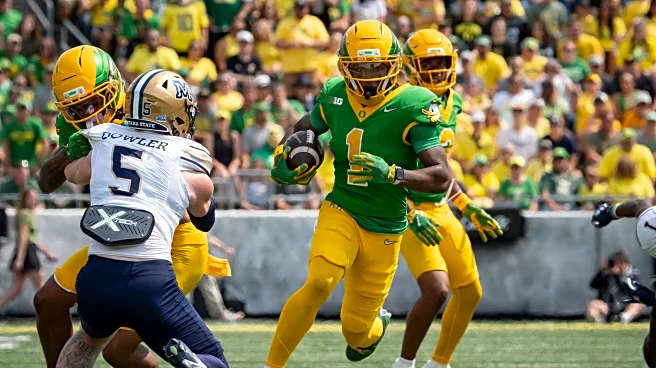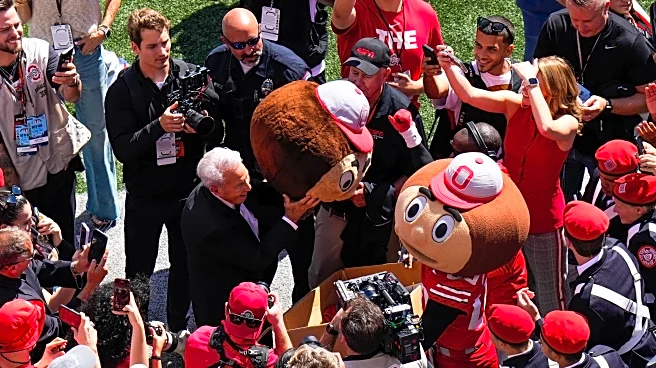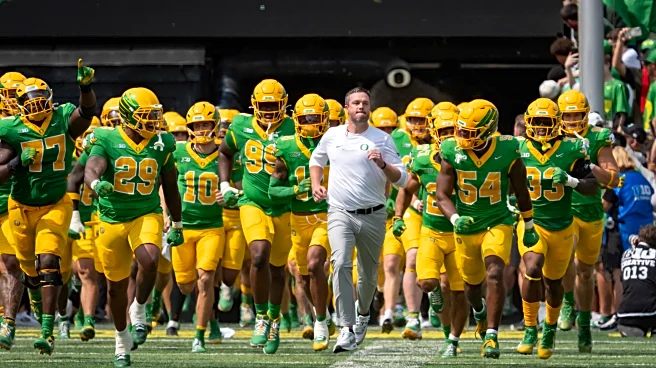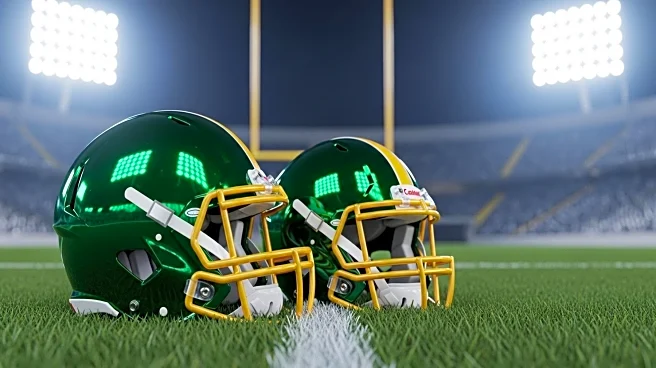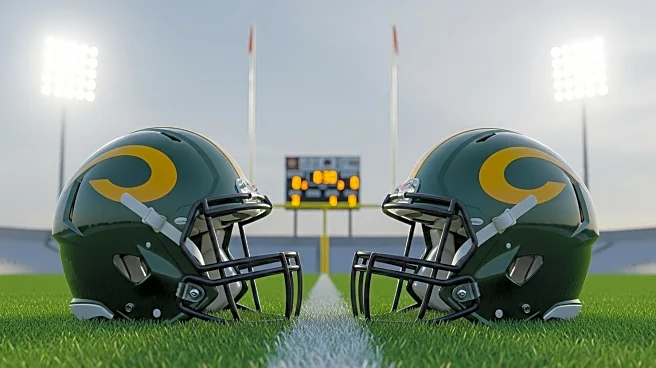
Oregon fans are no doubt relieved that Saturday’s game transpired much more like the 2023 opener against Portland State than last year’s uncomfortably close call against Idaho. For all competitive purposes, the game entered garbage time when the Ducks went up 31-0 in the second quarter. In that time Oregon ran 34 offensive plays at 61.76% efficiency and 14.71% explosiveness while averaging 6.1 yards per rush and 8.08 yards per pass. The defense was so dominant they only faced 17 snaps recording stats
of 70.59% efficiency, only 5.88% explosiveness rate and a mere 3.25 yards per play.
After this point both sides’ play calling changed significantly. While I excluded these drives from the team performance metrics, Oregon kept their starters in for two more drives in order to practice special situations. I charted these possessions on both offense and defense in order to grade individual players.
Offense
The offensive game plan was conservative, much like last year’s opener against the Vandals. The major difference between the two games is that on Saturday the offense had a championship level of efficiency in both the run and passing games, and completely avoided negative yardage plays (even penalties!) until the blowout was on. Looking only at the drive results, fans can be forgiven for thinking that concerns about the offensive line coming into this game were overblown. A closer look at the film, however, found cumulative error rates for the offensive line in run blocking to be 25.66%, far above the FBS average and nowhere near the Oregon standard. The effect of this is well illustrated when looking at runs between the tackles as opposed to outside runs while the starters were playing.
| Play Type | Plays | Efficiency | Explosive Rate | YPP |
|---|---|---|---|---|
| Inside Runs | 12 | 66.67% | 0.00% | 4.00 |
| Outside Runs | 9 | 44.44% | 33.33% | 8.56 |
While Oregon could pick up short yardage by counting on their running backs to push the pile, they couldn’t pick up chunk yardage unless they got the ball to the perimeter to challenge the Bobcats’ second level defenders in the open field. Montana State has one of the deepest defensive lines in the FCS, possibly better than some FBS teams the Ducks will face later this season. In 2023, run blocking was problematic against Portland State but that unit was able to gel and improve as the season went on. With the transfer effect, as well as a possible lingering injury to starting left guard E. Pregnon, this is an area of concern to keep an eye on.
Noah Whittington and Jayden Limar split most of the carries outside off garbage time. For reasons I have no insight on, Makhi Hughes didn’t see the field until the starter’s last two drives. True freshman Jordon Davison appeared as a short yardage specialist while Jay Harris saw duty as a third down back where his experience and size served him well as a blocker. Other players saw carries on sweeps, and I am curious if such calls will continue to be a staple of the offense going forward. Below is a representative sample of successful rushing plays.
(Reminder – you can use the gear icon in the bottom right corner to control the playback speed.)
- :00 – This was the first play of the game and it demonstrated two recurring themes: Oregon’s offensive line struggling in run blocking and Montana State’s defense struggling with the athleticism of the Ducks’ ball handlers. Every single Bobcat defender gets their helmets playside so RB #6 has to cut back and to his right and hope to find green grass. The safety MSU #5 has over pursued and lost backside contain. A good block downfield by WR #1 Dak. Moore makes for a huge gain.
- :12 – Stein didn’t call any of the perimeter screens that had been so ineffective last year until the second half, which was long after the game was decided. Instead he tried to get the ball to his fastest players in space by attacking the edge in the run game. The playside LB isn’t fooled and RT #71 misses him at first then has to risk a block in the back to get #1 Dak. Moore to the edge. He gets the defender just enough in the side to avoid a flag. The perimeter blocks from TE #9 Ja. Johnson along receivers #2 G. Bryant and #14 J. Lowe spring the freshman for an explosive run.
- :23 – The blocking isn’t great here on third and short, but it is good enough. The center #72 and LT #76 lunge out of their stances and lose their balance, allowing the playside DE to get the runner. The RT also doesn’t get off his double team quickly enough get an angle on the LB. The guards #73 K. Rogers and #74 D. Iuli neutralize the defensive tackles though, and that is enough for Whittington to squirt through the hole and get 4 yards on 3rd and 1.
- :27 – This the staple split-flow inside zone run that has been the basis of Oregon’s running game for nearly a decade. Lined up as an H-back, #18 K. Sadiq does a nice job leading RB #6 Whittington through the hole as LT. #76 I. World kicks out the DE. The LG and C, #74 and #72, fail to execute the chip-and-up double team. The center needs to get his helmet playside so the guard has a free release to the safety. Whittington has enough room to build up momentum and fall forward to set up 3rd and 1, but MT St. #5 is able to dive at his feet and save a touchdown.
The Bobcats greatest strength was their depth on the defensive line. Despite the final score, this unit fared well. While Oregon’s ball handlers proved difficult to bring down, there were no holes between the tackles that would allow for chunk yardage. Below are examples of failed rushing plays.
- :00 – This inside zone run is designed to go right up the A-gap to the offense’s right. It never has a chance to work as drawn up as both C #72 and RG #74 allow the defenders to get their helmets playside, and even RT #71 lunges out of his stance and doesn’t make solid contact with the safety. Whittington has to improvise and redirect to his left. On first down it is fine to get upfield and get what he can. In a different down and distance scenario he would want to try and beat the nickel defender to the outside.
- :07 – Moore is reading the DE to the offense’s right during the mesh, and he stays home so he hands off to #22 Harris running an outside zone to the left. At LT #76 needs to kick out the DE so the LG #74 can release from the double team and reach the corner. At center #72 has to get his helmet playside as RG #73 releases to block the safety. Exactly none of this happens as it is supposed to.
- :15 – This gets a replay because of TE #18 K. Sadiq’s athletic hurdle, but it’s really a simultaneous indictment of the Ducks perimeter blocking and excellent team defense from Montana State. The wide receiver #14 lined up to the offense’s left needs to block the corner so Sadiq has a path to the sideline, but instead goes to block the safety who is over 15 yards deep in the middle of the field and has no good angle on the play. The corner uses proper technique and goes low against the larger Sadiq. He won’t see another athlete that can do this the rest of the season, but even then he forces the ball carrier to slow down and relentless pursuit from the linebacker MT St. #34 results in only a three yard gain. Regardless of competition level, this is the kind of team defense that can win championships.
- :36 – This inside zone run is supposed to attack the A-gap on the offense’s left as the jet motion from WR #1 Dak. Moore pulls the linebackers outside. Once C #72 gets high out of his stance and is knocked into the primary running lane, RB #27 Limar has to bend back toward the B-gap on the offense’s left, straight into the unblocked backside corner. Even worse, MT St. #41 crosses his blocker’s face after redirecting the play and can help make the stop.
In his first start under OC Will Stein, quarterback Dante Moore showed a strong command of the offense. Contrary to the tendency the last few years, Oregon rotated in a large number of wide receivers and eight were targeted. Whether this is a new strategy or simply the staff testing different combinations in a live game remains to be seen. Kenyon Sadiq was the only TE used in the passing game, but I find it hard to believe that trend will continue. Interior pass protection was quite good, but the tackles posted poor error rates of between 20%-25% on drop backs. Perimeter pressure was usually mitigated by Moore getting the ball out quickly.
Though fans might have been disappointed not to see more deep shots Montana State was routinely playing “Cover-4” (two deep safeties and corners backpedaling at the snap) and only blitzed once in the entire first half. Emphasizing the quick game was sensible given the defense’s game plan. Oregon also waited until the third quarter to call a perimeter screen, and both plays succeeded despite blocking assignment errors from the receivers. Here is a sample of successful passing plays.
- :00 – It isn’t a huge gain, but this play showcases some of Moore’s exceptional gifts as a passer. When he sees his first read is covered, he reloads and looks to WR #2 G. Bryant breaking open to his right. Despite having to throw off his back foot as pressure closes in, he generates enough force from his core to deliver the ball with accuracy and velocity. His throwing motion is so compact this all happens in just under three seconds so the pass rush can’t get home despite both sides of the line failing to adjust to end/tackle stunts.
- :12 – This was the only time the Bobcats blitzed in the first half and the offense handled it with precision. The middle linebacker is showing that he will come right up the A-gap, so RB #22 Harris steps up to meet him as the left side of the offensive line slides to their left to account for the LB coming from that side. Moore knows from surveying the coverage this leaves two defenders over three receivers to his left at the snap. The receiver #2 G. Bryant already has the first down but adds a few yards with his moves in the open field.
- :37 – The RT #71 is being driven back into the quarterback’s lap, and RG #77 gets beaten around the edge in the slide protection. Moore sees the nickel defender has his eyes in the backfield and isn’t following WR #17 C. Perry into the flat. He makes a quick throw to negate the pressure and stay ahead of the chains while the team still has a time out available in a 2-minute situation.
- :45 – Moore sees Montana State backing out their corners to have four defenders in position against vertical routes. This means his best chance for a completion is one of the short hitch routes. He progresses from the field side to the boundary where he can get the ball to his receiver more quickly. He leads WR #4 M. Benson toward the down marker away from the defender. He already has the first down, but with the extra space from the accurate pass Benson can turn upfield and get out of bounds to stop the clock near the end of the half.
For all his poise, this was still Moore’s first game in over a year and there are areas he can improve as the season goes on. If pass blocking on the edge doesn’t show improvement in the coming weeks, it may be necessary to assign tight ends and backs to chip edge rushers in pass protection. Here are some examples of failed passing plays.
- :00 – The protection holds up pretty well here, but with the field condensed in the low red zone and seven defenders in coverage nobody can break open. The best chance might have been to dump off to #6 N. Whittington over the middle quickly while the umpire was shielding him from the defender. Moore instead opts to buy time for his receivers to find open space on 3rd down and ends up settling for a five yard scramble to set up a field goal.
- :09 – Moore makes the correct read to see that WR #3 Kasper will be open for an easy conversion against soft coverage. He’s right to throw the ball low and away from the defender, he’s just a bit off target.
- :16 – On the right side of the line OT #71 and OG #77 don’t properly handle the E/T stunt. They at least shove the DE back into the DT looping behind which, fortunately, knocks the free rusher off balance. This throw from Moore isn’t perfect, but it’s accurate enough that TE #18 needs to make this catch.
- :31 – The Bobcats try the inverse of their rush strategy from the previous clip, looping the DEs behind the DTs. On the offense’s left the LG #74 doesn’t pick up the end properly and Moore has to vacate the pocket. This lets the DT MT St. #41 get after him and the quarterback wisely throws the ball away to avoid a sack.
Defense
Montana State made it to the FCS National Championship Game last year on the strength of their running game. With a change at coordinator and quarterback this season, the hope is they will be able to complement this historical strength with downfield passing. The Bobcats had to shuffle their offensive line at the last minute due to injury, and it was quickly apparent they were (quite literally) out of their weight class against Oregon’s front. It remains to be seen how effective they will be in FCS play, but there were some positives for them even in a game as lopsided as this one.
The Duck’s front wasn’t only stout at the point of attack, but was frequently in the backfield and recorded several tackles for loss. Most of the DL and OLB players hythloday discussed in his roster preview. At linebacker the rotation was much more limited, with only Sr. #28 Bryce Boettcher, Jr. #54 Jerry Mixon, and R-Jr. Devon Jackson seeing meaningful snaps. Hopefully injured redshirt freshmen Dylan Williams and Brayden Platt will be available soon. Below is a sample of successful rush defense.
- :00 – This play is single handedly demolished by #52 A. Washington at NT who shoots through the A-gap and wraps up the running back. Consistent penetration was a theme all day for Oregon’s defense as DT #1 B. Alexander and DE #10 M. Uiagalelei arrive a moment later.
- :14 – Washington is lined up as a 3-tech to the offense’s right on this play, and once again he fires into the backfield at the snap. His blocker takes some inspiration from the Big Ten blocking style, but OLB #44 T. Tuioti and NT #99 T. Green have the RB and QB bracketed.
- :28 – Montana State tries to go right up the middle for a yard, but once again Washington fires through the offensive line. He slows the runner down enough for OLB #9 B. Purchase to finish the play off. This is a poor read from from the quarterback, the DB #7 steps toward the line of scrimmage at the snap. Had he pulled the ball his TE would have had an easy conversion on the toss.
- :41 – This is textbook defense of an inside zone read. From his OLB spot to the offense’s right #9 B. Purchase plays with proper leverage and QB hands off. He’s fast enough to pursue down the line of scrimmage where blitzing ILB #54 J. Mixon has split a double team and gotten a hand on the runner’s legs.
Former Stanford QB Justin Lamson never had a chance to showcase his arm strength on any deep throws, but was a factor in the running game as anticipated. Facing by far the most athletic defense they will see all season, Montana State needed any edge they could find. Below are examples of unsuccessfully defended rushing plays.
- :00 – The Bobcats keep the ball in the quarterback’s hands to use the RB as an extra blocker. At NT #50 holds against the double team but fails to disengage from the Bobcat’s LG #57. The edge defender #44. T. Tuioti catches up to the ball carrier quickly enough that the safety slipping doesn’t matter, but Montana State gets to a reasonable 3rd and 4.
- :07 – Montana State is in 12 personnel so the Ducks are expecting a run and have an extra linebacker, #9 B. Purchase to the offense’s left, on the field. What they aren’t expecting is a counter running away from the pullers. Purchase plays the pass until he is sure it is as run, as he has been coached. The play succeeds because ILB #26 steps down toward the flow of the blockers and doesn’t keep backside contain. This gives the running back an open lane.
- :15 – Nose tackle #52 A. Washington is where he was seemingly all day, deep in the backfield. Lamson sees his only chance is to pull the ball. The edge defender on the offense’s left, #9, takes one step too far down the line and Lamson knocks CB #3 backwards to convert.
- :23 – It was a long day for the Bobcat’s run blockers, but this play goes to them. Nothing fancy here, just outside zone to the strength of the formation. The left tackle and in-line TE take the defenders where they want to go and run DT #52 and OLB #44 out of the play. At ILB #54 gets slowed down by the RG (who barely avoids a tripping penalty). The running back has a free path to the sideline and CB #7 I. Obidegwu and S #21 A. Flowers have to chase him out of bounds.
With transfer CB Theron Johnson out, the Ducks turned to a large rotation of true and redshirt freshman in the secondary. Veteran transfers Jadon Canady (at nickel) and Dillon Thieneman (at safety) provided an experienced presence, but Oregon was able to contain the Bobcats by relying on their young talent. Here is a sample of successful pass defense.
- :00 – B. Boettcher, #28, blitzes from the ILB position and hurries this throw. The corner, #7 I. Obidegwu, drives on this short hitch route and earns a pass break up. He has a whole flock of team mates running to the ball in case they are needed.
- :07 – Lamson wants to get this ball away as fast as possible and get whatever he can on first down. A quick throw to the flat leaves no chance for the pass rush to affect the play, but ILB #54 J. Mixon runs through the catch and keeps the play to only three yards.
- :15 – Watch the interaction among the defenders at the line of scrimmage before the snap. With the run strength of the formation to the offense’s right, NT #50 T. Gray asks DT #1 B. Alexander to shift that direction. Senior “green dot” ILB #28 B. Boettcher then reminds them he’s coming on a blitz and gets them back in their correct gaps. Boettcher gets loose just as #10 M. Uiagalelei and #9 B. Purchase close on the QB from the edge. Lamson stands in and gets the ball to his receiver. I admit I have been critical of NB #0 D. Austin in the past, but he does an excellent job to get under the rub and tackle Montana State’s most productive receiver for a short gain.
- :28 – Notice the defenders at the bottom of your screen signalling and adjusting their assignments when the receivers shift position. The pocket collapses quickly and Lamson has to hurry the throw to avoid a sack and the ball is behind his receiver. Even if the pass was accurate, true freshman CB B. Finney is in a position to break it up.
With their run game stymied and unable to protect Lamson long enough to go deep, what success Montana State found on offense came in the quick passing game. A big emphasis for the Oregon’s linebackers going forward needs to be emphasizing coverage against RPOs. Though he lacks FBS stature, MT St. WR #14 Taco Howard showcased excellent acceleration and route running and was easily the best weapon for the Bobcats. Efficiency passing was one area where Montana State’s offense was lacking last year, so Big Sky defenses will have to beware. Here are some examples of unsuccessful pass defense.
- :00 – Lamson sees the nickel defender, #22 Canady, sneaking up to rush the passer. The ILB #26 needs to rotate over more quickly to replace the blitzer. He is still shuffling sideways when MT St. #14 T. Howard cuts inside to the vacated area of the field. The safety, #31 D. Thieneman, takes a good angle and prevents an even bigger gain.
- :08 – With three receivers to the boundary, the safety #2 is lined up over Howard in the slot. When the running back widens to the field ILB #26 D. Jackson has to go with him so there is no help over the middle against this mesh concept. Lamson releases the ball just in time and absorbs a big hit, but the umpire provides a natural rub and Thieneman has to come down and make the tackle again.
- :17 – The Bobcats come back to the mesh with Howard and TE MT St. #86. The Ducks send five pass rushers so ILB #28 is all alone in the middle of the field. He’s in a tough position, but Howard is more dangerous so he needs to try to get over the TE and follow the slot receiver.
- :27 – The rule for linebackers in the mint front defense is always to play the pass until the offense commits to the run, especially when the offense is behind the chains (after a penalty here). Both ILBs #28 and #26 violate this principle and step down to play the run, leaving nobody in the lane against the slant from TE MT. St. #89.
